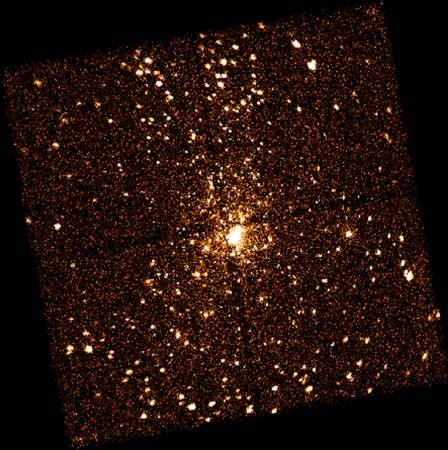Explanation: The stars of Orion shine brightly in northern winter skies where the constellation harbors the closest large stellar nursery, the Great Nebula of Orion, a mere 1500 light-years away. In fact, the apparently bright clump of stars near the center of this Chandra X-ray telescope picture of a portion of the nebula are the massive stars of the Trapezium - the young star cluster which powers much of the nebula's visible-light glow. But the sheer number of other stars seen in this X-ray image, which spans about 10 light-years, has surprised and delighted astronomers and this picture was recently touted as the richest field of X-ray sources ever recorded in a single observation. The picture does dramatically illustrate that young stars are prodigious sources of X-rays, thought to be produced in hot stellar coronas and surface flares in a young star's strong magnetic field. Our middle-aged Sun itself was probably thousands of times brighter in X-rays when, like the Trapezium stars, it was only a few million years old. The dark lines through the image are instrumental artifacts.
1999 2000 2001 2002 2003 2004 2005 2006 2007 2008 2009 2010 2011 2012 2013 2014 2015 2016 2017 2018 2019 2020 2021 2022 2023 2024 2025 |
Yanvar' Fevral' Mart Aprel' Mai Iyun' Iyul' Avgust Sentyabr' Oktyabr' Noyabr' Dekabr' |
NASA Web Site Statements, Warnings, and Disclaimers
NASA Official: Jay Norris. Specific rights apply.
A service of: LHEA at NASA / GSFC
& Michigan Tech. U.
|
Publikacii s klyuchevymi slovami:
star cluster - trapezium - Orion Nebula - Tumannost' Oriona - Oblasti zvezdoobrazovaniya - rentgenovskoe izluchenie - rentgenovskie luchi - rentgenovskie istochniki
Publikacii so slovami: star cluster - trapezium - Orion Nebula - Tumannost' Oriona - Oblasti zvezdoobrazovaniya - rentgenovskoe izluchenie - rentgenovskie luchi - rentgenovskie istochniki | |
Sm. takzhe:
Vse publikacii na tu zhe temu >> | |
